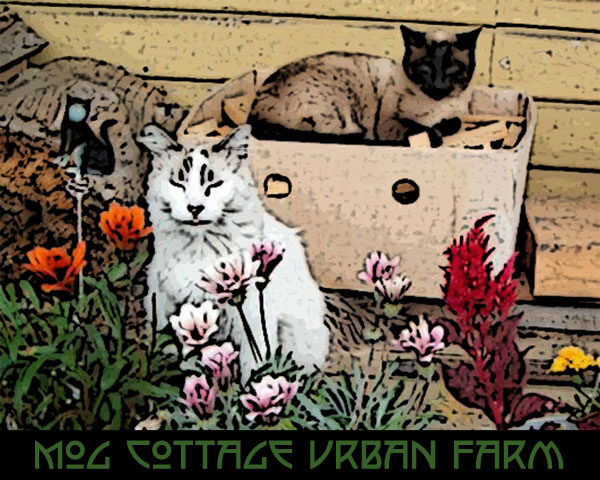Wow, another thing to keep track of and stash in our gardening repertoire. In the Feb/March addition of Organic Gardening magazine, Michele Owens writes an interesting article on the internal clocks of veg. The premise is if our turnips or radishes aren't mature before they bolt it could be because they weren't planted at the right time of the year and consequently, the length of light they need at certain growth stages is off kilter. According to biologist Takato Imaizumi of the University of Washington who is interviewed in this article, a plant's cells have an internal clock that rhythmically produces proteins that degrade and activate genes again in 24 hours. So, what I gather is that carrots and peas have regular internal sleep/wake cycles. If planted at the wrong time, they get jet lagged.
Now, I know what some of you are thinking in between fits of laughter- "What?!" Yep, your crop failures may not be from planting seeds before the soil temperature is warm enough for germination and the seeds rot.Your bolting lettuce may have hypertension issues from too much sun light, not too much heat. This theory may have some merit though. Imaizumi divides veg into 3 different categories: long-day flowering plants, short-day flowering plants, and day-neutral plants.
Long-day plants include carrot, cilantro, lettuce, peas, radish, spinach and turnip just to list a few. In other words, these veges need longer periods of light to flower. If you live in an area that often has cold springs, like the Pacific NW, long day veg planted in the spring languish until the weather gets warmer. Warmer soil also happens to coincide with more light. Many of these root crops are biennials that need a prolonged cold snap that triggers flowering in summer the following year. This mechanism is supposed to keep them from flowering the first summer, long enough to grow a good edible bit to harvest. Our prolonged cold spring may fool them and thus, when the days get long, they bolt. The plant germinates then shoots for the flowering stage because its internal clock says that's what it's supposed to do.The result is you get underdeveloped plants that flower before they're ready to harvest. The cure? Plant the seeds after the solstice for a fall crop. They develop well because they wouldn't flower until the following summer.
You may be surprised, but tomatoes can get too much light. They're short-day flowering plants. Ever notice that many of your tomato plants finally flower in the late summer to fall when the temperature starts to drop down too much to ripen the fruit? Indeterminate tomatoes just grow and grow and grow foliage until they bust out of their supports, then flower away in mid to late August. The sunlight promotes the vegetation, but the length of light promotes the flowering. This revelation may be why we need a greenhouse to really grow good tomatoes. They need the warmth, but not the light for the fruit to mature. In fact, many of the short-day crops grow better in warmer climates such as, pineapple, black-eyed peas, okra, pomegranate, sweet potato and as mentioned, tomato. Night and day are more evenly distributed all year compared to us, but the temperature doesn't drop to low to croak them before harvest time. Blueberries, June-bearing strawberries, common beans, cucumbers and raspberries grow here, but are either hardier or are at the mercy of our climatic swings.
Day neutral plants include alpine and everbearing strawberries, apple, many of the brassica crops, peach, pear, rhubarb and some cultivars of beans, cucumbers and corn, to name a few. These plants either like it hot or cooler.
Some crops are even sensitive to where they originated latitude-wise, depending on the variety. They evolved to survive at a certain latitude and therefore, light level. Although obviously not a veg, if you think about it, chickens require 16 hours of light a day to lay eggs, thus the seasonality of there egg laying cycle. Where do chickens come from (and don't say "eggs," duh)? Certain areas of the tropics, close to the equator where days are long enough to produce the 16 hour days without the big seasonal light/dark swings that we experience in the Northwest. I know of one backyard chicken aficionado who turns on the flood lights in his hen house until 2am during the winter months so he gets year-around eggs.
Unfortunately, if your long-day plants experience SAD, supplementing their fertilizer with melatonin won't work. However, the taxonomists are developing varieties that tweak that internal clock so we gardeners can grow things that otherwise would be difficult. Not only are our day lengths a consideration, Western Washingtonians experience prolonged cloud cover that can feel oppressive. That's another dimension to consider. Choosing varieties that are not only climate conditioned to ours, but also come from a similar latitude will help to ensure a successful crop.
Unfortunately, this bit of information is just one more thing to keep track of in the art of veg gardening. I could wallpaper my house with all of the charts I'm supposed to keep track of when, what, where and how to plant my veg. In this case, I think I'll start with the Solstice thing and see how it works out.
If you do too, let me know how it works out for you.


No comments:
Post a Comment
Tell me what you think. I'd love to hear your ideas and personal experiences.